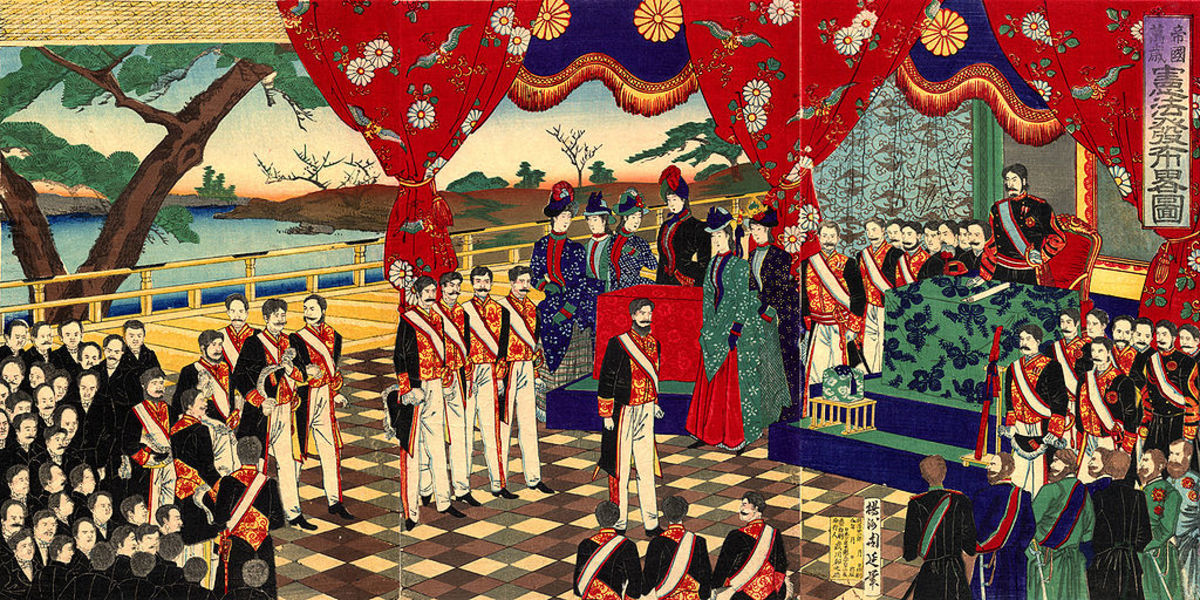The Meiji Restoration (1868–1912) was a transformative period in Japanese history, marking the end of feudal rule and the beginning of rapid modernization. While this era is often celebrated for its advancements in technology, education, and governance, it also had profound—and often overlooked—effects on Japan’s sex industry. From the decline of Edo-era pleasure quarters to the rise of new forms of adult entertainment, the Meiji period reshaped Japan’s approach to sexuality and social norms.
For foreign visitors, understanding this history provides valuable context for Japan’s modern adult entertainment scene. In this guide, we’ll explore how the Meiji Restoration influenced Japan’s sex industry, the cultural shifts it triggered, and the legacy it left behind.
1. The Meiji Restoration: A Brief Overview
The End of Feudalism
The Meiji Restoration began in 1868, when the Tokugawa shogunate was overthrown, and power was restored to the Emperor. This marked the end of Japan’s feudal system and the start of a centralized, modern state.
Westernization and Modernization
The Meiji government embarked on a mission to modernize Japan, adopting Western technologies, institutions, and cultural practices. This included reforms in education, military, and industry, as well as changes to social norms and values.
2. The Edo-era Sex Industry: A Foundation

Pleasure Quarters and Courtesans
During the Edo period (1603–1868), licensed pleasure quarters like Yoshiwara in Edo (Tokyo) were hubs of art, culture, and entertainment. Courtesans (oiran) were celebrated as artists and entertainers, and the sex industry was an accepted part of society.
Shunga and Erotic Art
Erotic art (shunga) flourished during this time, reflecting a society that viewed sexuality as natural and joyful.
3. The Meiji Restoration’s Impact on the Sex Industry
1. The Decline of the Pleasure Quarters
- Western Influence: The Meiji government sought to present Japan as a “civilized” nation to the West, leading to the suppression of practices deemed backward or immoral.
- Legal Reforms: The Prostitution Prevention Law (売春防止法) was introduced, criminalizing prostitution and dismantling the licensed pleasure quarters.
2. The Rise of New Forms of Adult Entertainment
- Cafés and Bars: Western-style cafés and bars emerged, offering new venues for socializing and entertainment.
- Geisha Culture: Geisha, who had traditionally been entertainers rather than sex workers, became symbols of Japanese culture and refinement.
3. Changing Attitudes Toward Sexuality
- Moral Reform: The Meiji government promoted Confucian and Christian values, emphasizing chastity and monogamy.
- Public Health: Concerns about sexually transmitted diseases led to increased regulation of the sex industry.
4. The Light of Modernization
1. Empowerment of Women
- Education: The Meiji period saw the introduction of compulsory education for girls, providing new opportunities for women.
- Labor Rights: Some women found employment in factories and offices, gaining financial independence.
2. Cultural Preservation
- Geisha and Traditional Arts: Despite the decline of the pleasure quarters, geisha and traditional arts like tea ceremony and flower arrangement were preserved and celebrated.
3. Urbanization and Innovation
- New Entertainment Venues: The rise of theaters, cinemas, and dance halls provided new forms of entertainment for the masses.
5. The Shadow of Modernization
1. Exploitation and Inequality
- Poverty and Prostitution: Many women, particularly from rural areas, were forced into prostitution due to economic hardship.
- Human Trafficking: The Meiji period saw an increase in human trafficking, with women and girls sold into brothels.
2. Stigma and Marginalization
- Social Stigma: Sex workers faced increased stigma and discrimination, as the Meiji government sought to present a “moral” image to the West.
- Legal Persecution: The Prostitution Prevention Law criminalized sex work, driving the industry underground and making workers more vulnerable.
3. Cultural Loss
- Decline of Traditional Arts: The suppression of the pleasure quarters led to the loss of traditional arts and crafts associated with the sex industry.
6. The Legacy of the Meiji Restoration
1. Modern Japan’s Sex Industry
- Soaplands and Hostess Clubs: The modern sex industry, including soaplands and hostess clubs, reflects the legacy of the Meiji period, blending tradition with modernity.
- Legal Gray Areas: Japan’s adult entertainment industry operates in a legal gray area, a legacy of the Meiji government’s ambivalence toward sex work.
2. Cultural Attitudes
- Ambivalence Toward Sexuality: Japan’s modern attitudes toward sexuality—both permissive and restrictive—can be traced back to the Meiji period.
- Gender Roles: The Meiji period reinforced traditional gender roles, which continue to influence Japanese society today.
7. Exploring Meiji-era History in Modern Japan
Museums and Historical Sites
- Edo-Tokyo Museum (Tokyo): Offers exhibits on the Meiji Restoration and its impact on Japanese society.
- Yoshiwara Memorial (Tokyo): A tribute to the historic pleasure quarters and their cultural significance.
- Meiji Mura (Aichi): An open-air museum featuring preserved Meiji-era buildings and artifacts.
Cultural Experiences
- Geisha Performances: Attend a traditional geisha performance in Kyoto or Tokyo to experience the artistry of the Meiji period.
- Onsen Towns: Visit historic hot spring towns like Atami or Kusatsu, which flourished during the Meiji era.
8. Ethical Considerations for Travelers

Respect Local Norms
- Approach Japan’s adult entertainment scene with cultural sensitivity and respect.
- Avoid imposing your own moral judgments on Japanese practices.
Support Ethical Businesses
- Choose venues with transparent practices and good reputations.
- Avoid venues that exploit workers or engage in illegal activities.
9. Real-Life Stories: Travelers’ Experiences
Case Study 1: The History Buff
Tom (USA):
“Learning about the Meiji Restoration gave me a whole new perspective on Japan’s sex industry. It’s fascinating to see how history shapes modern culture.”
Case Study 2: The Cultural Explorer
Lina (Germany):
“Visiting a geisha performance in Kyoto was like stepping back in time. It’s amazing how much of the Meiji era’s legacy is still alive today.”
10. FAQ: Your Questions Answered
Q: How did the Meiji Restoration change Japan’s sex industry?
A: It led to the decline of Edo-era pleasure quarters and the rise of new forms of adult entertainment, while also introducing stricter moral and legal regulations.
Q: Can I visit historic sites related to the Meiji-era sex industry?
A: Yes, museums and memorials in Tokyo and Kyoto offer insights into this fascinating history.
Q: Is it ethical to visit modern adult entertainment venues in Japan?
A: Yes, as long as you choose reputable venues and respect local norms.
Ready to Explore Japan’s History and Culture?
If you’re intrigued by the Meiji Restoration and its impact on Japan’s sex industry, let us guide you through this fascinating chapter of history. For readers who value cultural sensitivity, we curate private tours that include:
- Visits to museums and historical sites related to the Meiji era.
- Pre-tour briefings on the history and cultural significance of Japan’s sex industry.
- Custom itineraries blending history, culture, and nightlife.
Contact us today through this site, and we’ll craft an experience that’s as enlightening as it is unforgettable. Whether you’re a history buff or a curious traveler, we promise a journey into the heart of Japan’s past and present—no clichés, no judgment.
The Meiji Restoration left a lasting legacy on Japan’s sex industry, shaping the country’s modern culture in profound ways. Discover this history the right way, and you’ll walk away with a deeper understanding of what makes Japan uniquely itself.
Reach out now, and let’s turn fascination into connection. 🌸


